Related Research Articles

"Eritrea" is an ancient name, associated in the past with its Greek form Erythraia, Ἐρυθραία, and its derived Latin form Erythræa. This name relates to that of the Red Sea, then called the Erythræan Sea, from the Greek for "red", ἐρυθρός, erythros. The Italians created the colony of Eritrea in the 19th century around Asmara, and named it with its current name. After World War II Eritrea was annexed to Ethiopia. In 1991 the communist Ethiopian government was toppled by Eritrean forces and earned their independence. Eritrea officially celebrated its 1st anniversary of independence on April 27, 1994.

The Eritrean Defence Forces (EDF) are the combined military forces of Eritrea composed of three branches: Eritrean Army, Eritrean Air Force and Eritrean Navy. The Army is by far the largest, followed by the Air Force and Navy. The Commander-in-Chief of the EDF is the President of Eritrea. Their military role stems from Eritrea's strategic geographical location, located on the Red Sea with a foothold on the Bab-el-Mandeb strait.

The Gulag, GULAG, or GULag was the government agency in charge of the Soviet network of forced labor camps set up by order of Vladimir Lenin, reaching its peak during Joseph Stalin's rule from the 1930s to the early 1950s. English-language speakers also use the word gulag to refer to all forced-labor camps that existed in the Soviet Union, including camps that existed in the post-Lenin era.
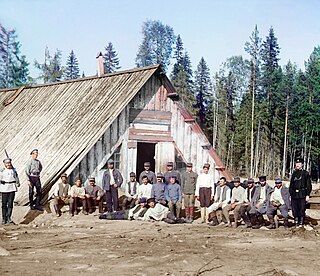
A prisoner of war (POW) is a person who is held captive by a belligerent power during or immediately after an armed conflict. The earliest recorded usage of the phrase "prisoner of war" dates back to 1610.

Laogai, short for laodong gaizao (劳动改造), which means reform through labor, is a criminal justice system involving the use of penal labor and prison farms in the People's Republic of China (PRC) and North Korea (DPRK). Láogǎi is different from láojiào, or re-education through labor, which was the abolished administrative detention system for people who were not criminals but had committed minor offenses, and was intended to "reform offenders into law-abiding citizens". Persons who were detained in the laojiao were detained in facilities that were separate from those which comprised the general prison system of the laogai. Both systems, however, were based on penal labor.

The Solovki special camp, was set up in 1923 on the Solovetsky Islands in the White Sea as a remote and inaccessible place of detention, primarily intended for socialist opponents of Soviet Russia's new Bolshevik regime. The first book on the Gulag, namely, In the Claws of the GPU (1934) by Francišak Aljachnovič, described the Solovki prison camp.

The Dahlak Archipelago is an island group located in the Red Sea near Massawa, Eritrea. It consists of two large and 124 small islands. The pearl fisheries of the archipelago have been famous since Roman times and still produce a substantial number of pearls.
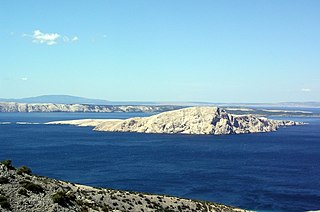
Goli Otok is a barren, uninhabited island that was the site of a political prison which was in use when Croatia was part of Yugoslavia. The prison was in operation between 1949 and 1989.
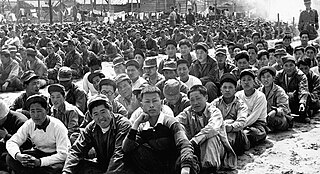
A prisoner-of-war camp is a site for the containment of enemy fighters captured by a belligerent power in time of war.
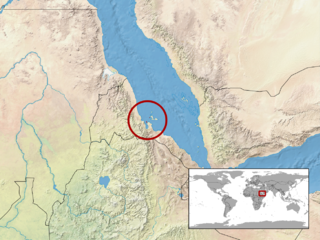
Echis megalocephalus, also known commonly as the big-headed carpet viper and Cherlin's saw-scaled viper, is a species of venomous snake in the family Viperidae. The species is endemic to one island in the Red Sea off the coast of Eritrea. There are no subspecies that are recognized as being valid.
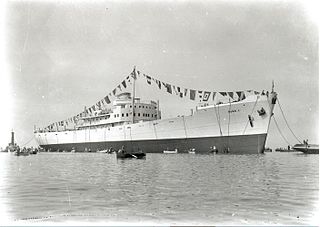
The Italian ship Ramb I was a pre-war "banana boat" converted to an auxiliary cruiser during World War II. Ramb I operated as an armed merchant in the Red Sea and was ordered to sail to Japan after the fall of Massawa to the Allies. She was sunk in the Indian Ocean before she could reach her intended destination.

Eritrea, officially the State of Eritrea, is a country in the Horn of Africa region of Eastern Africa, with its capital at Asmara. It is bordered by Ethiopia in the south, Sudan in the west, and Djibouti in the southeast. The northeastern and eastern parts of Eritrea have an extensive coastline along the Red Sea. The nation has a total area of approximately 117,600 km2 (45,406 sq mi), and includes the Dahlak Archipelago and several of the Hanish Islands.

The Italian Empire, known as the Italian colonial empire between 1936 and 1943, began in Africa in the 19th century and comprised the colonies, protectorates, concessions and dependencies of the Kingdom of Italy. In Africa, the colonial empire included the territories of present-day Eritrea, Somalia, Libya, and Ethiopia; outside Africa, Italy possessed the Dodecanese Islands, Albania, and some concessions in China, including in Tianjin.
Nakura or Nokra is an Eritrean island in the Dahlak Archipelago situated west of Dahlak Kebir. Nakura has an area of 6.44 km², and reaches a height of 48 meters.

Italian Eritrea was a colony of the Kingdom of Italy in the territory of present-day Eritrea. The first Italian establishment in the area was the purchase of Assab by the Rubattino Shipping Company in 1869, which came under government control in 1882. Occupation of Massawa in 1885 and the subsequent expansion of territory would gradually engulf the region and in 1889 borders with the Ethiopian Empire were defined in the Treaty of Wuchale. In 1890 the Colony of Eritrea was officially founded.
Eiraeiro is a secret prison in Eritrea. Most sources give the location of Eiraeiro as being situated near the village of Gahtelay, in the Northern Red Sea Region. However, in an article in the Guardian, Eiraeiro is cited as being located approximately 10 miles from the capital, Asmara.
A prison island is an island housing a prison. Islands have often been used as sites of prisons throughout history due to their natural isolation preventing escape.
Alem Bekagn, or 'Kerchele Prison', was Ethiopia's central prison until 2004. Located in Addis Ababa, the prison possibly existed as early as 1923, under the reign of Empress Zewditu, but became notorious after Second Italo-Ethiopian War as the site where Ethiopian intellectuals were detained and killed by Italian Fascists in the Yekatit 12 massacre. After the restoration of Emperor Haile Selassie, the prison remained in use to house Eritrean nationalists and those involved in the Woyane rebellion. Under the Communist Derg regime that followed, the prison was the site of another mass killing, the Massacre of the Sixty, and of the torture and execution of rival groups in the Red Terror. The prison remained a site of human rights abuses until the Ethiopian People’s Revolutionary Democratic Front entered Addis Ababa on 28 May 1991, after which it became a normal prison. The prison was closed in 2004 and demolished in 2007 to allow the construction of the headquarters of the African Union.

Internal exile was used to punish political dissidents by various Greek governments, including the Metaxas dictatorship, the government during the Greek Civil War, and the Greek junta. Those targeted were typically sent to smaller Greek islands. Over 100 locations were used for exile at various times in the 20th century.
References
- ↑ Michael R. Ebner. Geoff Simons. Ordinary Violence in Mussolini's Italy. New York, New York, USA: Cambridge University Press, 2011. P. 261.
- ↑ Anthony D'Avray. Lords of the Red Sea:The History of a Red Sea Society from the Sixteenth to the Nineteenth Centuries. Otto Harrassowitz Verlag, 1996. P. 222.